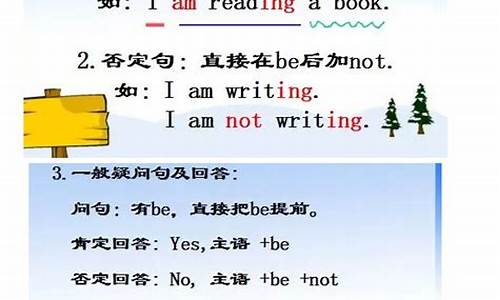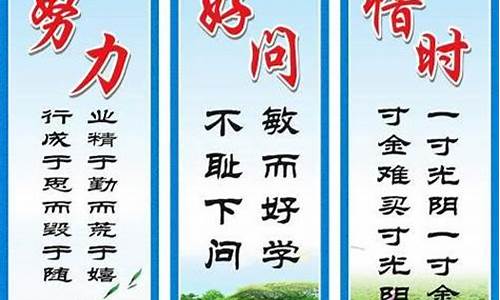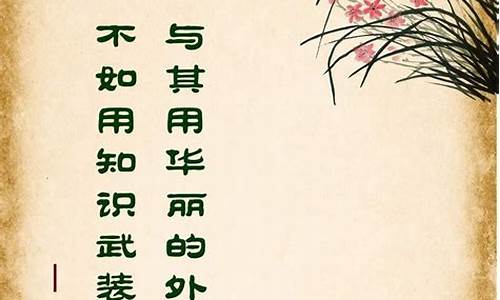您现在的位置是: 首页 > 经典语录 经典语录
现在进行时名词复数的句子_现在进行时的英语句子单数复数
tamoadmin 2024-08-15 人已围观
简介1.英语中现在进行时的用法2.现在进行时句型结构是什么3.要英语的对话要长一点的你面要有一般现在进行时的句子现在进行时表示动作发生的时间是“现在”,动作目前的状态是“正在进行中”.所谓“正在进行中”,是指在谈到这件事的时候,这个动作还在进行中.至于它是什么时候开始的,什么时候会停下来,不是我们关心的.所以“正在进行时”的,可能发生几年了,也可能只有几分钟.仍在进行中这是“正在进行时”的关键所在.它
1.英语中现在进行时的用法
2.现在进行时句型结构是什么
3.要英语的对话要长一点的你面要有一般现在进行时的句子

现在进行时表示动作发生的时间是“现在”,动作目前的状态是“正在进行中”.所谓“正在进行中”,是指在谈到这件事的时候,这个动作还在进行中.至于它是什么时候开始的,什么时候会停下来,不是我们关心的.所以“正在进行时”的,可能发生几年了,也可能只有几分钟.仍在进行中这是“正在进行时”的关键所在.它是一件持续进行的事情.
编辑本段现在进行时的构成 现在进行时的构成是:主语+be+v.ing〔现在分词〕形式
第一人称单数I+am+ing.
第一人称复数We+are+ing.
第二人称单(复)数 You+are+ing
第三人称单数 He(She,it)+is+ing
第三人称复数 They+are+ing
肯定句:主语+be(is/am/are)+现在分词
否定句:主语+be(is/am/are)+not+现在分词
一般疑问句:be(is/am/are)+主语+现在分词
特殊疑问句:特殊疑问词+相应be动词+主语+现在分词+Sth?
间接引语中改为过去进行时.?
编辑本段变化规则 1.直接+ ing(例:sleep+ing sleeping)
2.去掉不发音的e+ing(例:bite-e+ing biting)
3.重读闭音节,以辅音字母加元音字母加辅音字母结尾的词,要双写尾字母再加ing(例:swim+m+ing=swimming)
4.以ie结尾的重读闭音节,变ie为y+ing (例:die-dying lie-lying)
5结尾为c且c读作/k/时,在结尾加k再加ing,如picnic-picnicking
现在进行时的基本用法:
A表示现在( 指说话人说话时) 正在发生的事情.
例:We are waiting for you.
B. 表示现阶段正在进行的动作,说话时未必正在进行.
例:Mr. Green is writing another novel.
(说话时并未在写,只处于写作的状态.)
例:She is learning piano under Mr. Smith.
C.已经确定或安排好的但不确定会不会发生的将来活动.
I'm leing for a trek in Nepal next week.(我下周要去尼泊尔旅行)
We're flying to Paris tomorrow.(我们明天乘飞机去巴黎)?
编辑本段句型构成 现在进行时
助动词be 动词的现在分词(ing形式).
be的变化
在现在时中,be 要根据人称代词和名词的单复数不同,而分别使用am/is/are,即:I am/he/she/it 包括单数名词和不可数名词用is,you/we/they 包括复数名词用are.?
现在进行时
注意:be 动词在现在时里算作“助动词”,翻译正在进行时的时候,be不能解释为“是”,否则不通顺.它只是和现在分词一起构成“进行时”.
动词加ing的规则
现在分词是在动词后加上ing 构成.如:starting,working, coming, sitting 等都是现在分词.现在分词的变化规则是固定的,大家用心记一下就可以了.
(1)直接在谓语动词后加ing. 例如:going, starting, working,looking.
(2)去掉词尾不发音的e,再加ing. 例如 leing,making,coming,writing.
注意:如果单词结尾的e发音,则不能去掉,也直接加ing. 例如:see -seeing/agree - agreeing .
另外,有少数动词比较特殊,请用心记住:例如:lie - lying/die - dying/tie - tying/picnic - picnicking.
(3) 对于重读闭音节词,双写末尾字母再加ing. 例如:sitting, beginning,getting,putting.running
这一条规律,必须要弄清什么是“重读闭音节”.下面再举一些双写的例子:
run - running
stop - stopping
cut - cutting
control - controlling
put - putting?
编辑本段时间状语 可用来表示现在进行时的时间状语,常用的有:now, this week, at this moment,right now 等;或者告诉你一个准确的现在时间,或者用look, listen提醒听者注意正在发生的事.例如:
They are playing basketball now.现在他们正在打篮球.
Listen! She is singing an English song.听,她正在唱英语歌.
Look at the picture. The children are flying kites in the park.看这幅图.那些孩子正在公园放风筝.
We are making model planes these days.这些天我们在做飞机模型.
It's 6:30 now. I am getting up. 现在是6:30.我正在起床.?
编辑本段句型分析 1.一般疑问句是将be移到主语前面,句末加问号,读升调.
be+主语+doing sth
Are they putting up the scaffolding? Yes, they are. / No, they aren't.
Is he showing a foreign guest round the city? Yes, he is. / No, he isn't.
2.否定句式是在be动词后加not.
主语+be+not+doing sth
I am not working.
He isn't runnig or the track.
The students aren't playing football.?
编辑本段使用场合 1.当句中出现的表示时间的词是now, at the moment (此刻、现在)等时,表示句子要说明的是现在正在发生的事,动词应用现在进行时.
Linda's brother is watching TV in his bedroom now.
琳达的哥哥现在正在他的卧室里看电视.
We're far from home. What are our parents doing at the moment?
我们现在远离家,我们的父母此刻在干什么呢?
2.当句中出现的时间状语是these days, this week, this month等时,如果句子所要表达的意义是在这一阶段正在发生的事,则动词应用现在进行时.
These days we are helping the farmers work on the farm. 这些天我们在农场帮农民们干活.
They're hing a test this week. 这一周他们在进行一次考试.
Mr Cheng is visiting our village this month. 这个月程先生在我们村访问.
3.在句中出现了Look, Listen, Can't you see? 等暗示词时,说明后面谓语动词的动作正在发生,该动词应用现在进行时.
Look! Maria and Tom are dancing under the tree.
看!玛丽亚和汤姆正在树下跳舞.
Listen! Our English teacher is singing the popular English song.
听!我们英语老师正在唱那首流行的英文歌曲.
Many children are swimming in the river. Can't you see?
许多小孩在河里游泳,你难道看不见吗?
4.注意根据上下文的暗示,句子的谓语动词可能应用现在进行时.
— Where is Mr Wang? 王先生在哪儿?
— Oh, he is reading a newspaper in the office. 噢,他正在办公室看报.
(问句询问王先生在哪儿,应说明他现在在哪儿,故答句应说明他现在正在做的事,用现在进行时.)
—Is that boy Jack?那个男孩是杰克吗?
— No,Jack is doing his homework in the classroom. 不是,杰克正在教室做作业呢.
(答句中说明的杰克做作业的情况应发生在现在,应用现在进行时.)?
编辑本段注意事项 1.在英语中,并不是所有的动词都要使用正在进行时.例如一些表示状态和感觉的动词,一般不用进行时态,而是用现在一般时表示.例如:
I hear someone singing. 我正听见有人唱歌.
Do you see anyone over there? 你看到那里有什么人吗?
What does he think of it? 他觉得这怎么样?
如果这些词使用正在进行时态,句子带有某种感彩.例如:
Are you seeing someone off? 你在给谁送行吗?
They are hearing an English talk. 他们在听一个英语报告.
2.现在进行时还有另外一种含义,即它们能表达即将发生的事情,相当于一般将来时.能够用来表示将来状况的动词有:arrive, come, do, get, go, he, lee, meet, play, return, see, spend, start, stay, wear, work等.
We are leing on Friday.我们星期五出发.
Are you going anywhere tomorrow?你明天准备去哪儿?
A foreign guest is giving a lecture this afternoon.今天下午一个外国客人将给我们作报告.
Are you staying here till next week? 你打算在这里呆到下个星期吗?
在表示将来的情况下,特别是be going to do sth. 这种结构,已经没有多少“去”的意思了,几乎就是用来表达“将要、打算”做什么事情.例如:
It is going to be rather cold tomorrow.明天很可能非常冷.
She is not going to speak at the meeting.她不打算在那个会上发言.
3.当其与always、forever、continually、constantly 等副词连用时表示重复的动作,而这种动作可能使人不满,厌倦或满意.例如:
①She is perpetually interfering in my affairs.
她老是干预我的事. (不满)
②The students are making progress constantly.
学生们在不断进步. (满意)
现在进行时的标志有很多,如:listen,look,now,these days,Be quiet!/Don't talk等等.?
编辑本段特殊情况 1.有些动词从结构来看是现在进行时,但却是表示将要发生的事,而不表示动作现在正在进行.这些动词往往是一些表示位置移动变化的动词,如:go , come , lee , fly , move, start, begin , arrive, , stay, return等.
Next month my family is moving to Beijing.
下个月,我家就要搬到北京去了.(搬的动作并非现在发生,而将在下个月发生.)
My aunt is leing for Shanghai at eleven o'clock tomorrow morning.
明天早上十一点我婶婶将离开去上海.
2.并不是所有动词都有进行时,一些动词一般在句中不能用现在进行时态,而应用一般现在时.这些动词往往是等表示情感状态、知觉认识、愿望或短暂性的动词.例如:see(明白),know, want, like, hear, he(有), think, hope, hate等.
3.在时间、条件状语从句中,有时可用现在进行时代替一般将来时.
When you are passing my way,please drop in.
你什么时候路过我家,请进来坐.?
编辑本段被动语态 现在进行时
现在进行时由主动语态变被动语态时应注意以下一些问题:
1.也像其它时态由主动语态变被动语态一样,首先弄清楚用现在进行时的句子中哪些可以由主动语态变为被动语态.我们知道,在简单句的五个基本句型中,有三个基本句型(S V O,S V o O,S V O C)可以由主动语态变为被动语态;有两个基本句型(S V,S V P)不能由主动语态变为被动语态.所以,当这三个基本句型(S V O,S V InO DO,S V O OC)的谓语动词用了现在进行时时才有可能由主动语态变为被动语态.例如:
They are studying the milu deer at the research centre.(S V O)→
The milu deer are being studied at the research centre.
She is teaching the boy a lesson.(S V InO DO)→
The boy is being taught a lesson.
Now he is making the girl laugh.(S V O OC)→
Now the girl is being made to laugh.
还应注意到一些动词很少用于被动语态,因此这些动词在句子谓语用了现在进行时时也常没有被动语态.如:We are hing supper now.一般不能变为Supper is being had now..
2.及物动词现在进行时由主动语态变被动语态时有三种句式:①主语(第一人称单数I) am being 过去分词 其他成分;②主语(第二人称单、复数you,第一人称复数we和第三人称复数they等) are being 过去分词 其他成分;③主语(第三人称单数 he,she,it等) is being 过去分词 其他成分.所以,当句子谓语动词用了现在进行时由主动语态变被动语态时谓语动词要由原来作宾语变为主语时的名(代)词的数来决定,从上面三种句式中选择合适的一种句式.例如:
They are collecting money for the broadband project.→
Money is being collected for the broad-band project.
They are not protecting some animals well enough.→
Some animals are not being protected well enough.
3.当变为主语的原来的宾语(名/代词)有较长的动词不定式短语(复合结构)、介词短语、从句修饰或有补足语时,动词不定式短语、介词短语、从句和补足语等,一般都仍然保留在原来的位置上.例如:
They are revising the laws to protect the rights of women and children.→
The laws are being revised to protect the rights of women and children.
They are writing a report about the negative effects of cell phones in school.→
A report is being written about the negative effects of cell phones in school.
Scientists are keeping a sick milu deer alive at the centre.→
A sick milu deer is being kept alive at the centre(by scientists).
4.如果用在现在进行时的句子中的谓语动词是动词短语或习惯用语,那么这个动词短语或习语只把动词变为被动语态,其他部分保持不变.例如:
The parents are taking good care of their test-tube baby.→
Their test-tube baby is being taken good care of(by the parents).
5.当用了现在进行时的句子结构是"S V In O DO"句型时,既可以把间接宾语变为被动句的主语,也可以把直接宾语变为被动句的主语,但如果是后者,可根据动词的习惯用法,把间接宾语改写为to或for引起的介词短语.例如:
George is sending his friend's phone texts and pictures.
His friend's phone is being sent texts and pictures(by George).
Texts and pictures are being sent to his friend's phone(by George).
She is making Toma new coat.
Tom is being made a new coat.
A new coat is being made for Tom.
6.用了现在进行时的句子由主动语态变为被动语态后,原来充当主语的名/代词(特别是人称代词)在一般情况下可以省略掉,如果有必要强调时可用by表示,常放在句子后面.例如:
They are adding new functions to the phones.
New functions are being added to the phones(by them).
Scientists are studying the life of the milu deer at present.
The life of the milu deer is being studied at present by scientists.
7.当用了现在进行时的句子由主动语态变为被动语态后,其否定式的构成主要把not放在谓语动词中第一个助动词(am ,are或is)后面构成,而疑问式的构成则是把句子谓语动词的第一个助动词(am,are或is)移到句子前(第一个字母要大写),然后在句子后面加上问号而成.例如:
New nature parks are being started in China.
New nature parks are not being started in China.(否定式)
Milu deer are being sent to China from Britain.
Are milu deer being sent to China from Britain?(疑问式)
如果是特殊疑问句还要在这个助词前面加上适当疑问词.例如:
Why is money being collected
编辑本段与一般现在时区别 一般现在时表示经常性动作,现在进行时表示现在或现阶段正在发生的动作.例如:
He studies hard. 他(经常)努力学习.
He is studying hard. 他(此刻或现阶段)正在努力学习.
一般现在时表示现在发生的动作,现在进行时表示眼前看得见的动作.例如:
Boats pass under the bridge. 船从桥下穿过.
The boat is passing under the bridge.
船正从桥下穿过.?
编辑本段基本用法 (1)表示(说话瞬间)正在进行或发生的动作.
(2)也可表示当前一段时间内的活动或现阶段正在进行的动作. (二)谓语构成:be (am/ is/ are)+v-ing (动词的现在分词)
I’m watching TV now.
They’re playing football.
(三)现在分词的构成.
(1)一般情况下在动词词尾加ing.
go→going ask →asking look→looking
(2)以不发音的e结尾的动词,去掉e加ing.
he →hing take→taking make→making write→writing
(3)以一个辅音字母结尾的重读闭音节,双写最后一个字母,再加-ing.
get→getting sit→sitting put→putting run→running
swim→swimming begin→beginning shop→shopping
(四)现在进行时态的肯定式、否定式、疑问式及简略回答.
(1)肯定式:be+v-ing She is singing in the next room.
(2)否定式:be+not+v-ing The students aren’t cleaning the room.
(3)一般问句:be动词提前.
肯定答语Yes,主语+be,否定答语No,主语+be not.
Are you playing the computer game? Yes, I am. /No, I am not.
(4)特殊问句:对谓语动词进行提问的:What+be +主语+doing+其他?
What is the old man doing under the tree?
对其他成份进行提问的,疑问词+一般疑问句?
Where is the boy swimming?
Who is she waiting for?
三. 现在进行时与一般现在时的区别
(一)现在进行时表示动作的暂时性,而一般现在时表示动作的习惯性和经常性
I am watching TV now. (暂时性)
I watch TV every day. (经常性)
(二)现在进行时可表示短暂性动作,而一般现在时表示长久性动作.
Lucy is living in Beijing.(短时间居住)
Lucy lives in Beijing. (长久性居住)
(三)现在进行时表示的动作可带有感彩,而一般现在时所表述的动作通常是事实.
You’re always forgetting the most important things. (责备)
He is always helping others. (赞扬)
He often helps others. (事实)?
英语中现在进行时的用法
there be加doing。
现在进行时是英语的一种时态,表示现在进行的动作或存在的状态。在英语时态中,“时“指动作发生的时间,”态“指动作的样子和状态。现在进行时表示动作发生的时间是“现在”,动作目前的状态是“正在进行中”。
例如:There is a cute boy playing football.
有一个可爱的小男孩正在踢足球。
There is a yellowbird singing on the branch.
有一只黄雀在枝头唱歌。
扩展资料:
1、当动词be后所接的名词是单数可数名词或不可数名词时,be 应该取单数is;当其后所接的名词是复数的可数名词时,be用复数are。
There's a man at the door.门口有个人。
There is some le juice in the bottle.瓶子里有些苹果汁。
There are some strangers in the street.大街上有一些陌生人。
2、如果There be 后面是几个并列名词做补语时,动词be的形式和最靠近它的那个名词保持数的一致。
There is an ashtray and two bottles on the shelf. 架子上有一只烟灰缸和两个瓶子。
There are two bottles and an ashtray on the shelf. 架子上有两个瓶子和一个烟灰缸。
现在进行时句型结构是什么
现在进行时的用法:
a. 表示现在( 指说话人说话时) 正在发生的事情。
例如:We are waiting for you. 我们在等你。
b. 习惯进行:表示长期的或重复性的动作,说话时动作未必正在进行。
Mr. Green is writing another novel. 格林先生在写另一部。
(说话时并未在写,只处于写作的状态。)
She is learning piano under Mr. Smith. 她在史密斯先生的帮助下学钢琴。
c. 表示渐变的动词有:get, grow, become, turn, run, go, begin等。
The lees are turning red. 树叶渐渐变红了。
d. 与always, constantly, forever 等词连用,表示反复发生的动作或持续存在的状态,往往带有说话人的主观色彩。
You are always changing your mind. 你总是改变想法。
扩展资料特殊情况
1.有些动词从结构来看是现在进行时,但却是表示将要发生的事,而不表示动作现在正在进行。这些动词往往是一些表示位置移动变化的动词,如:go , come , lee , fly , move, start, begin , arrive, , stay, return 等。
Next?month?my?family?is?moving?to?Beijing.
下个月,我家就要搬到北京去了。(搬的动作并非现在发生,而将在下个月发生。)
My?aunt?is?leing?for?Shanghai?at?eleven?o'clock?tomorrow?morning.
明天早上十一点我婶婶将离开去上海。
2.并不是所有动词都有进行时,一些动词一般在句中不能用现在进行时态,而应用一般现在时。这些动词往往是等表示情感状态、知觉认识、愿望或短暂性的动词。例如:see(明白),know, want, like, hear, he(有), think, hope, hate等。
特殊用法
现在进行时与短暂性动词搭配使用时可表示将来的时态。例如:
The bus is coming. 公交车来了。
Lily is leing tonight, we would better send her off. 莉莉今晚要走了,我们最好去送送她。
要英语的对话要长一点的你面要有一般现在进行时的句子
现在进行时的构成是:主语+be动词(am /is /are)+动词ing形式〔现在分词〕
1、肯定句:主语+be动词(am /is /are)+动词ing+其他。
2、否定句:主语+be动词(am /is /are)+not+动词ing+其他。
3、一般疑问句:be动词+主语+动词ing+其他。
肯定回答:Yes,主语+ be.
否定回答:No,主语+ be not.
4、特殊疑问句:特殊疑问词+一般疑问句
回答要根据实际情况来回答。
注:is not可以缩写成isn‘t,are not可以缩写成aren’t,但是am not在现代英语中不可以缩写——古英语及诗歌中am not缩写成ain‘t。
用法:
1、当变为主语的原来的宾语(名/代词)有较长的动词不定式短语(复合结构)、介词短语、从句修饰或有补足语时,动词不定式短语、介词短语、从句和补足语等,一般都仍然保留在原来的位置上。例如:
They are revising the laws to protect the rights of women and children.
他们正在修改法律以保护妇女和儿童的权利。
2、如果用在现在进行时的句子中的谓语动词是动词短语或习惯用语,那么这个动词短语或习语只把动词变为被动语态,其他部分保持不变。例如:
The parents are taking good care of their test-tube baby.
父母在照顾他们的。
现在进行时:表示现在正在进行的动作,由“be动词 + 动词的现在分词”构成。
现在进行时的肯定句
句型
(1)第一人称:主语 + am + 现在分词 + ……
eg. I am watching TV. 我现在看电视。
(2)第三人称单数:主语 + is + 现在分词 + ……
eg. She is washing the dishes. 她正在洗澡。
(3)第二人称及复数人称:主语 + are + 现在分词 + ……
eg. They are playing games. 他们正在做游戏。
现在进行时的否定句
句型 主语 + 相应be动词 + not + 现在分词 + ……
eg. He isn't watching TV. 他没在看电视。
I am not cooking. 我没有在做饭。
We aren't heing English calss. 我们没在上英语课。
◆注意◆ is not和are not可缩写为isn't和aren't。
现在进行时的一般疑问句
句型 相应be动词 + 主语 + 现在分词 + ……?
eg. Are you dancing? 他们正在跳舞吗?
Is he drawing a picture? 他正在画一张画吗?
Are you talking with your friend? 你正和你的朋友谈话吗?
现在进行一般疑问句的答语
句型
(1)肯定回答:Yes, 主语 + 相应be动词。
(2)否定回答:No, 主语 + 相应be动词 + not。
eg. Are you listening to the music? Yes, I am. / No, I am not. 你正在听音乐吗?是的,我正在听。/ 不,我没在听。
Is Aunt Wang knitting a sweater? No, she isn't. 王阿姨正织毛衣吗?不,她没有。
现在进行时的特殊疑问句
句型 特殊疑问词 + 相应be动词 + 主语 + 现在分词 + ……?
eg. What are you doing? 你正在干什么?
Who is singing a song? 谁在唱歌呢?
Why are they cleaning their room? 他们为什么在打扫房间?
现在进行时特殊疑问句的答语
回答特殊疑问时,根据不同的疑问词的情况来决定回答方式。回答what提问时,答语是现在进行时的肯定形式;回答who提问时,只需说明主语是谁,再加相应的be动词即可。
eg. What is he doing? He is writing a letter. 他正在干什么?他正在写信。
Who is swimming in the lake? Jim is. 谁正在湖里游泳?吉姆正在游泳。
现在进行时的用法
表示阶段或现在正在发生的动作。
eg. Look! He is flying a kite. 看,他正在放风筝。
It is raining now. 天正下着雨。
Don't make any noise. The baby is sleeping. 不要吵,孩子正在睡觉。
表示一个最近按或安排要进行的动作,可代替将来时,此时一定要与表示将来的时间状语连用;这样应用的主要动词有:go, come, lee, start, arrive, return等。
eg. Are you going to Tianjin tomorrow? 你明天去天津吗?
He is leing for Beijing at eight tomorrow. 明天八点他要去北京。
动词现在进行时常与always搭配使用,表示反复出现或习惯性的动作,隐含说话人的赞扬、喜好或厌恶的情绪。
eg. He is always talking. 你老是说个没完没了。
She is always helping people. 她总乐于助人。
时间状语:now, these days, recently等。如果句子中出现提示语,如look,listen等也经常用现在进行时。
要特别注意有些动词没有进行时态
1、表示状态、思想、感情和感觉的动词,如:see, hear, love, know, want, hope, think等,没有进行时态。
2、当he/has作为“拥有”时,没有进行时态,但表示“开会,吃饭,玩得高兴”等意思时,可以用进行时表达。
eg. I am hing many books. (这是错误的句子)
I am hing a good time. (这才是正确的句子)
动词的现在分词形式构成方法
情况
构成
动词原形
现在分词形式
一般动词原形结尾
加-ing
go
ask
Going
asking
以不发音的字母e结尾
去e加-ing
Write
close
Writing
closing
以重读闭音节结尾,如末尾只有一个辅音字母
双写末尾字母加-ing
Dig
Put
begin
Digging
Putting
beginning









